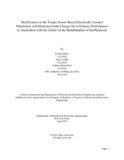| dc.contributor.advisor | Azad, A.K.M. Abdul Malek | |
| dc.contributor.author | Sarker, Pronob | |
| dc.contributor.author | Bari, Nafis Al | |
| dc.contributor.author | Zim, Ishtiak Ahmad | |
| dc.contributor.author | Rafi, Md. Abdullah Al Mohaymen | |
| dc.date.accessioned | 2019-07-11T04:04:34Z | |
| dc.date.available | 2019-07-11T04:04:34Z | |
| dc.date.copyright | 2019 | |
| dc.date.issued | 2019-04 | |
| dc.identifier.other | ID 15121025 | |
| dc.identifier.other | ID 15121035 | |
| dc.identifier.other | ID 15321022 | |
| dc.identifier.other | 19121150 | |
| dc.identifier.uri | http://hdl.handle.net/10361/12333 | |
| dc.description | This thesis is submitted in partial fulfillment of the requirements for the degree of Bachelor of Science in Electrical and Electronic Engineering, 2019. | en_US |
| dc.description | Cataloged from PDF version of thesis. | |
| dc.description | Includes bibliographical references (pages 96-97). | |
| dc.description.abstract | For millennia, physically challenged people have had to find different means to live their daily lives. In the early times, most of the used methods were very inconvenient and needed constant aid of other people. With time, however, these methods have been improving constantly and with the dawn of the revolutionary wheelchair, the hardship of physically challenged people was reduced a great deal. Although it is uncertain, the first known wheelchair is said to be made in 1595 in Spain, and since then with the advancement in technology, the wheelchair has come a long way and today’s sophisticated wheelchairs make life for physically challenged people very convenient. However, these sophisticated wheelchairs are also very expensive and unaffordable by the financially unprivileged people of the third world countries. Hence, an idea was proposed to produce an electrical wheelchair with integrated torque sensor technology which would ensure longer battery life and cut down overall costs and therefore, would be more affordable and convenient for the unprivileged people globally. The wheelchair was successfully produced, however had certain limitations and inconveniences. This thesis paper is about the modification works done on the existing torque sensor based electrically assisted wheelchair with dedicated solar charger kit to enhance performance. | en_US |
| dc.description.statementofresponsibility | Pronob Sarker | |
| dc.description.statementofresponsibility | Nafis Al Bari | |
| dc.description.statementofresponsibility | Ishtiak Ahmad Zim | |
| dc.description.statementofresponsibility | MD. Abdullah Al Mohaymen Rafi | |
| dc.format.extent | 100 pages | |
| dc.language.iso | en | en_US |
| dc.publisher | Brac University | en_US |
| dc.rights | Brac University theses are protected by copyright. They may be viewed from this source for any purpose, but reproduction or distribution in any format is prohibited without written permission. | |
| dc.subject | Physically challenged | en_US |
| dc.subject | Wheelchair | en_US |
| dc.subject | Financially unprivileged | en_US |
| dc.subject | Torque sensor technology | en_US |
| dc.subject | Dedicated solar charger kit | en_US |
| dc.subject.lcsh | Electric Power Production and Distribution | |
| dc.subject.lcsh | Solar cells | |
| dc.subject.lcsh | Electronics -- Experiments | |
| dc.title | Modification on the torque sensor based electrically assisted wheelchair with dedicated solar charger kit to enhance performance in association with the center for the rehabilitation of the paralysed | en_US |
| dc.type | Thesis | en_US |
| dc.contributor.department | Department of Electrical and Electronic Engineering, Brac University | |
| dc.description.degree | B. Electrical and Electronic Engineering | |

